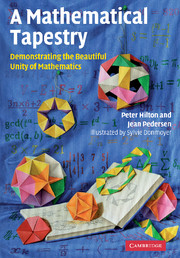Book contents
- Frontmatter
- Contents
- Preface
- Acknowledgments
- 1 Flexagons – A beginning thread
- 2 Another thread – 1-period paper-folding
- 3 More paper-folding threads – 2-period paper-folding
- 4 A number-theory thread – Folding numbers, a number trick, and some tidbits
- 5 The polyhedron thread – Building some polyhedra and defining a regular polyhedron
- 6 Constructing dipyramids and rotating rings from straight strips of triangles
- 7 Continuing the paper-folding and number-theory threads
- 8 A geometry and algebra thread – Constructing, and using, Jennifer's puzzle
- 9 A polyhedral geometry thread – Constructing braided Platonic solids and other woven polyhedra
- 10 Combinatorial and symmetry threads
- 11 Some golden threads – Constructing more dodecahedra
- 12 More combinatorial threads – Collapsoids
- 13 Group theory – The faces of the trihexaflexagon
- 14 Combinatorial and group-theoretical threads – Extended face planes of the Platonic solids
- 15 A historical thread – Involving the Euler characteristic, Descartes' total angular defect, and Pólya's dream
- 16 Tying some loose ends together – Symmetry, group theory, homologues, and the Pólya enumeration theorem
- 17 Returning to the number-theory thread – Generalized quasi-order and coach theorems
- References
- Index
8 - A geometry and algebra thread – Constructing, and using, Jennifer's puzzle
Published online by Cambridge University Press: 10 November 2010
- Frontmatter
- Contents
- Preface
- Acknowledgments
- 1 Flexagons – A beginning thread
- 2 Another thread – 1-period paper-folding
- 3 More paper-folding threads – 2-period paper-folding
- 4 A number-theory thread – Folding numbers, a number trick, and some tidbits
- 5 The polyhedron thread – Building some polyhedra and defining a regular polyhedron
- 6 Constructing dipyramids and rotating rings from straight strips of triangles
- 7 Continuing the paper-folding and number-theory threads
- 8 A geometry and algebra thread – Constructing, and using, Jennifer's puzzle
- 9 A polyhedral geometry thread – Constructing braided Platonic solids and other woven polyhedra
- 10 Combinatorial and symmetry threads
- 11 Some golden threads – Constructing more dodecahedra
- 12 More combinatorial threads – Collapsoids
- 13 Group theory – The faces of the trihexaflexagon
- 14 Combinatorial and group-theoretical threads – Extended face planes of the Platonic solids
- 15 A historical thread – Involving the Euler characteristic, Descartes' total angular defect, and Pólya's dream
- 16 Tying some loose ends together – Symmetry, group theory, homologues, and the Pólya enumeration theorem
- 17 Returning to the number-theory thread – Generalized quasi-order and coach theorems
- References
- Index
Summary
Required materials
Strips of paper (preferably of different colors)
Heavy paper, such as lightweight cardboard
Paper clips
Optional materials
Ruler
Compass
Facts of life
In many instances involving the use of geometry in the real world, we need to make adjustments to take into account the realities of life. For example, paper comes in various thicknesses (which are never zero!) and the interior of every container must be larger than what it contains. These and other very elementary facts of reality affect how we are able to take practical advantage of the theorems obtained from our study of the geometry of idealized lines, planes, and solids.
As this section title implies, we concern ourselves here with the details of practical construction, in this case of a particular set of nested polyhedra. Namely, we construct an octahedron and 4 tetrahedra that fit inside a larger tetrahedron that, in turn, fits inside a cube. As you will see – assuming that you become actively involved in carrying out these instructions – overcoming the difficulties encountered in using, in a real-life situation, a theory that is perfect in principle is very much a skill of the eyes and hands as well as of the mind.
What follows is first a description of the construction, along with some hints about how to solve Jennifer's puzzle; this is followed by some important mathematical consequences to be gained by constructing the puzzle.
- Type
- Chapter
- Information
- A Mathematical TapestryDemonstrating the Beautiful Unity of Mathematics, pp. 110 - 122Publisher: Cambridge University PressPrint publication year: 2010

